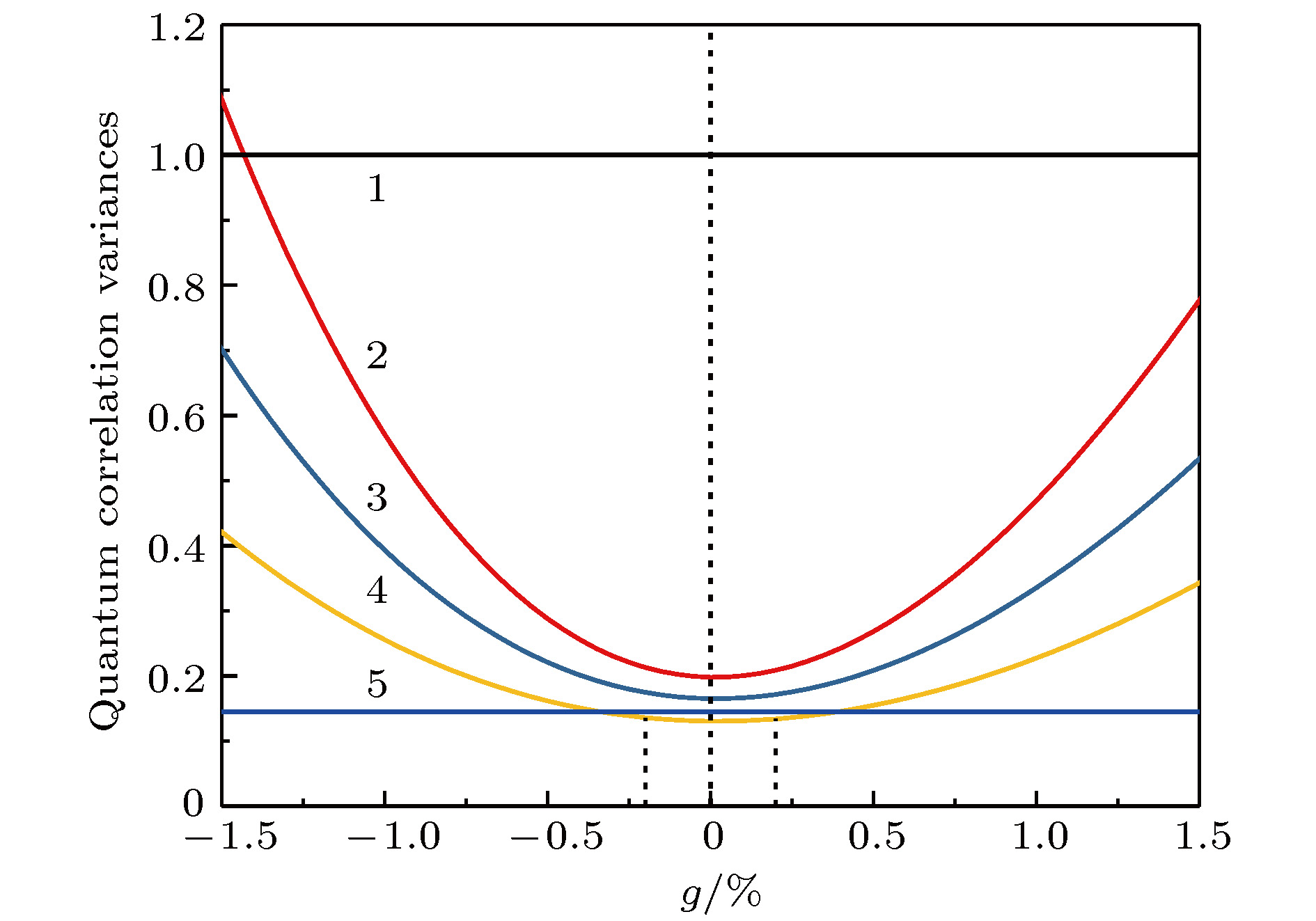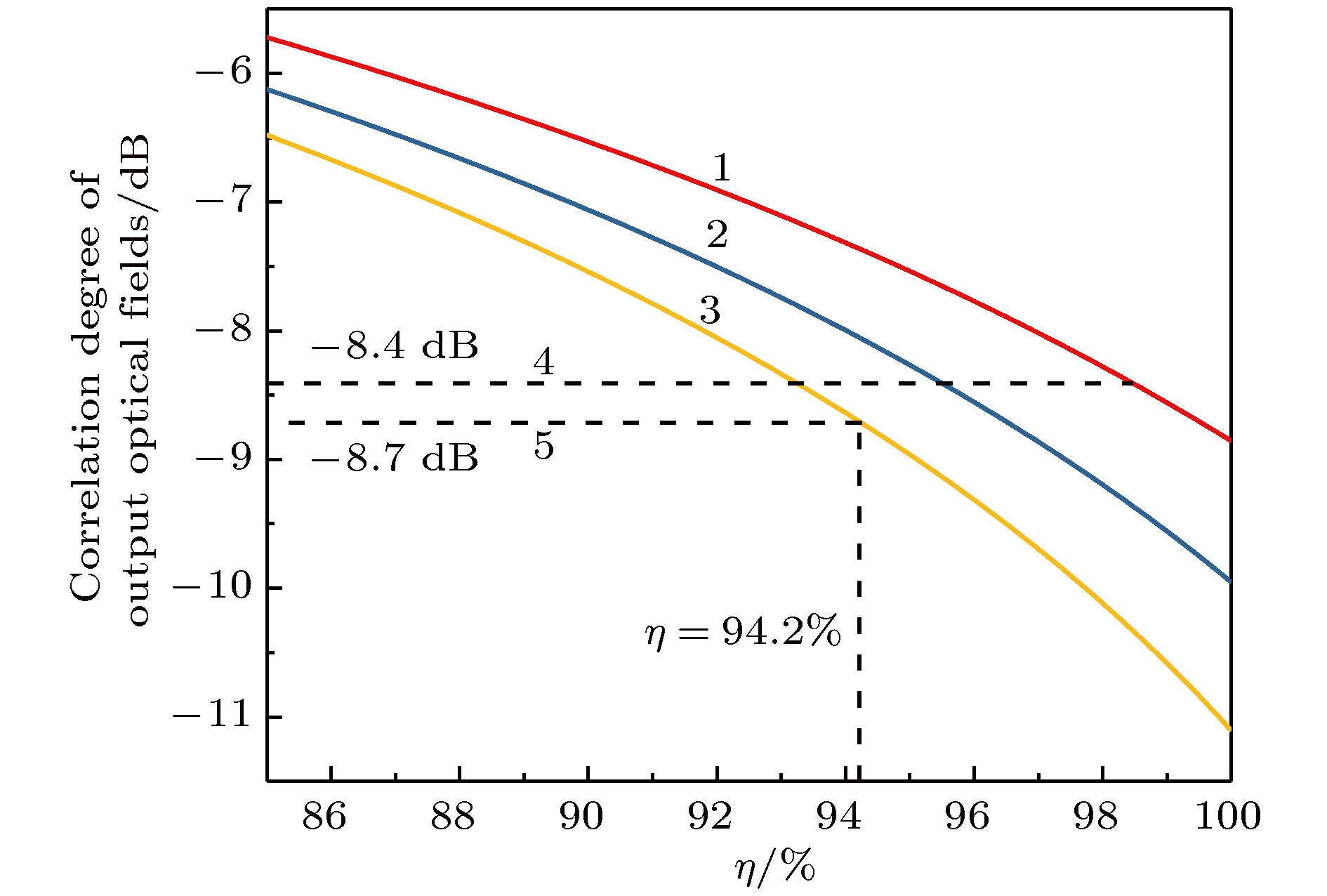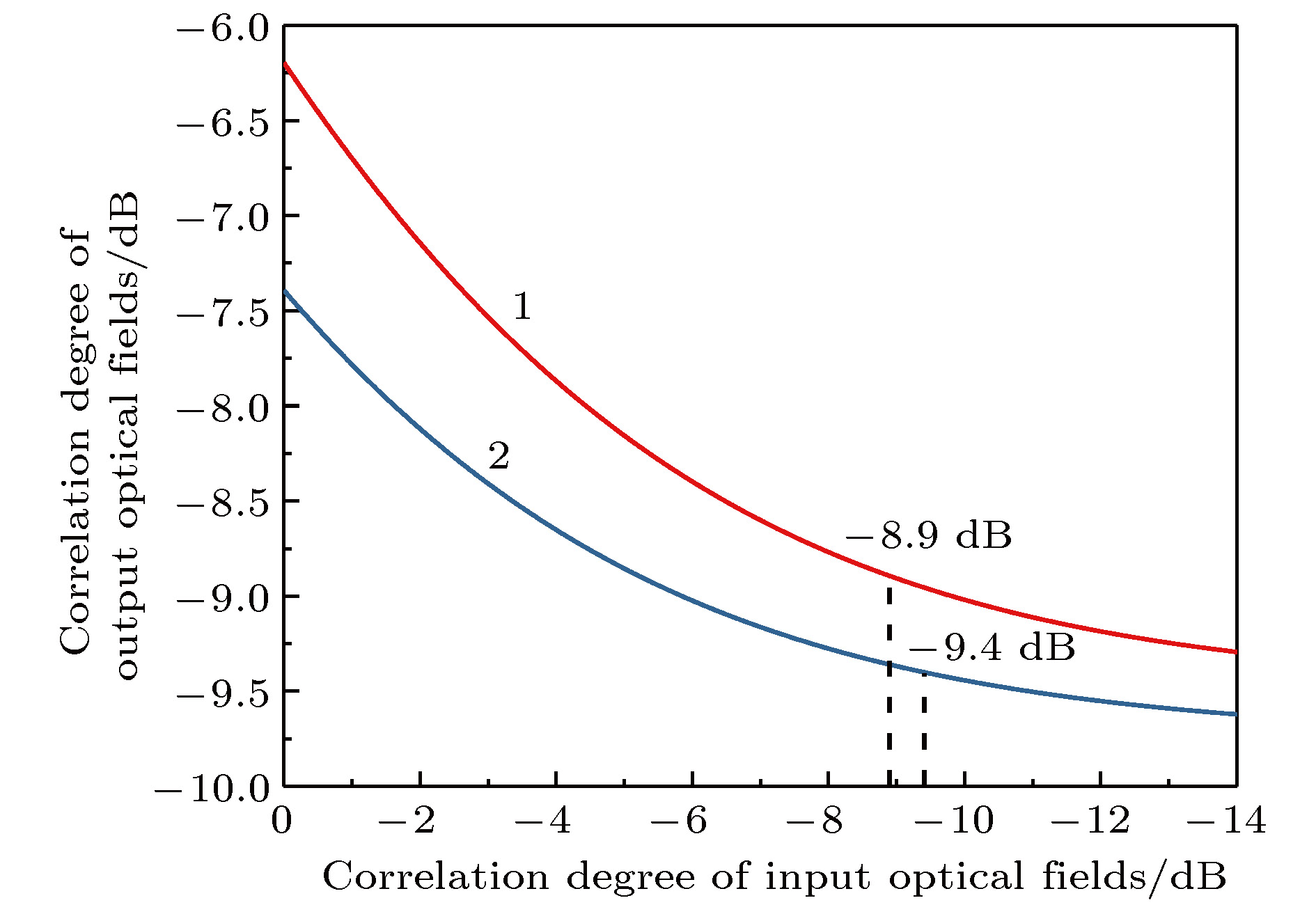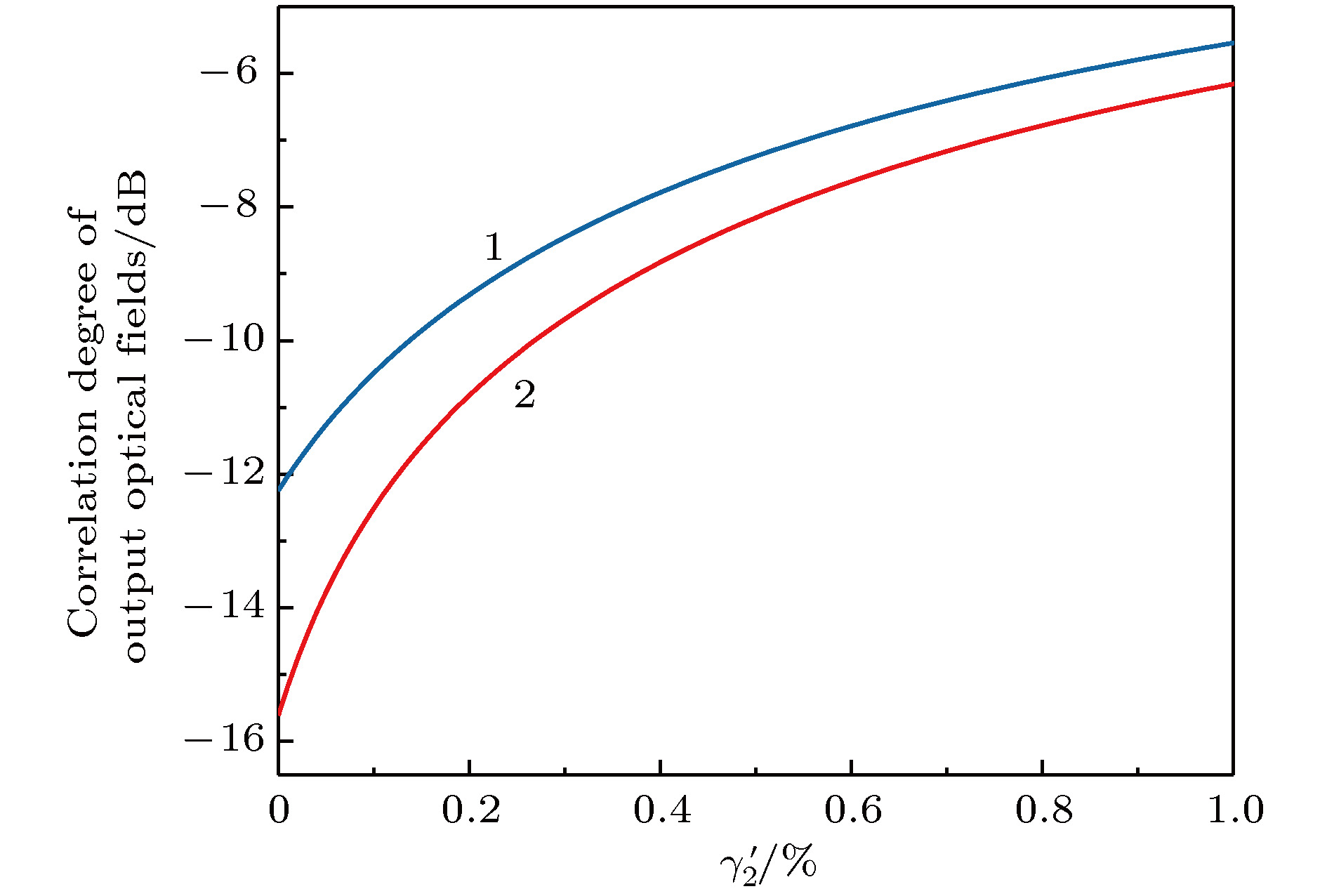-
高纠缠度的纠缠源是实现高保真度量子信息传输与处理的保障, 因为受到光学元器件自身性能不完美的限制, 通过有效的操控手段来提高光场的纠缠度是十分必要的. 连续变量Einstein-Podolsky-Rosen纠缠态光场可以利用工作在阈值以下的非简并光学参量放大器来获得. 将两个非简并光学参量放大器级联, 可以利用第二个光学腔来操控第一个光学腔输出的纠缠态光场, 在一定条件下实现光场的纠缠增强. 本文通过理论分析设计出两种光学腔级联的实验系统, 其中, 纠缠产生装置采用具有三共振结构的半整块驻波腔, 输出到目前为止世界上单腔获得两组份纠缠态光场纠缠度的最高值, 操控光学腔采用驻波腔或四镜环形腔的结构. 详细对比分析了不同结构的操控腔对纠缠增强效果的影响, 得出利用不同腔形作为操控腔的最佳实验方案. 同时分析了级联腔输出光场的纠缠度随不同物理参量的变化关系, 得出进一步优化的最佳实验系统参量, 为实验获得更高纠缠度的纠缠态光场提供了依据.Entanglement source with high entanglement degree is the guarantee for accomplishing the quantum information transmission and process with higher fidelity. Continuous variable Einstein-Podolsky-Rosen (EPR) entangled optical field with quantum correlation of amplitude and phase quadrature is a basic and important quantum resource in the quantum information science area, which can be obtained by a non-degenerate optical parametric amplifier (NOPA) operated below the threshold pump power. Because of the limitation of the imperfect performance of optical components in optical cavity, we should find efficient methods of implementing quantum manipulation to improve the entanglement degree of the entangled state of light. Connecting NOPA1 and NOPA2 in series, the entangled state of light output from the NOPA1 can be manipulated by NOPA2, and the entanglement degree can be enhanced under certain conditions. To improve the entanglement degree to a greater extent, the structure of the NOPA1 is chosen as a half-monolithic standing-wave optical resonator with the triple resonance of the pump and two subharmonic modes. The NOPA1 is able to output the entangled optical fields with an entanglement degree of 8.4 dB, which is the highest entanglement generated by a single device so far. The structure of the NOPA2 can be chosen as a standing-wave optical cavity or a four-mirror ring optical cavity. According to the different structures of the NOPA2, we theoretically design two kinds of optical systems with two cascaded cavities and compare the effects of the two optical systems on the continuous variable EPR entanglement cascaded enhancement in detail. Based on the above contrastive analysis, when the entanglement degree of the input optical fields is 8.4 dB and the transmissivity of the output coupler is lower, the structure of a four-mirror ring optical cavity for NOPA2 cannot enhance the entanglement degree, so the optical system including NOPA2 with standing wave cavity structure and the optical isolator with high transmission efficiency is appropriate. When the transmissivity of the output coupler and transmission efficiency of the optical isolator are higher, the structure of the NOPA2 should be chosen as a standing-wave optical cavity, otherwise the structure of the NOPA2 should be chosen as a four-mirror ring optical cavity. We also theoretically analyze the dependence of the correlation degree of output optical fields on physical parameters. The results show that under the conditions of higher input and output coupling efficiency, higher transmission efficiency and lower intro-cavity loss, the entangled state of light with higher entanglement degree can be obtained experimentally. This provides the reference for obtaining entangled optical fields with higher entanglement degree in the future.
-
Keywords:
- Einstein-Podolsky-Rosen entangled optical fields /
- manipulated optical cavity /
- entanglement enhancement
[1] Bouwmeester D, Pan J W, Mattle K, Eibl M, Weinfurter H, Zeilinger A 1997 Nature 390 575
 Google Scholar
Google Scholar
[2] Furusawa A, Sorensen J L, Braustein S L, Fuchs C A, Kimble H J, Polzik E S 1998 Science 282 706
 Google Scholar
Google Scholar
[3] Boschi D, Branca S, Marini F D, Hardy L, Popescu S 1998 Phys. Rev. Lett. 80 1121
 Google Scholar
Google Scholar
[4] Vaidman L 1994 Phys. Rev. A 49 1473
 Google Scholar
Google Scholar
[5] Braunstein S L, Kimble H J 1998 Phys. Rev. Lett. 80 869
 Google Scholar
Google Scholar
[6] Bowen W P, Schnabel R, Lam P K, Ralph T C 2004 Phys. Rev. A 69 012304
 Google Scholar
Google Scholar
[7] Eberle T, Händchen V, Duhme J, Franz T, Werner R F, Schnabel R 2011 Phys. Rev. A 83 052329
 Google Scholar
Google Scholar
[8] Mizuno J, Wakui K, Furusawa A, Sasaki M 2005 Phys. Rev. A 71 012304
 Google Scholar
Google Scholar
[9] Stoler D 1970 Phys. Rev. D 1 3217
 Google Scholar
Google Scholar
[10] Mehmet M, Vahlbruch H, Lastzka N, Danzmann K, Schnabel R 2010 Phys. Rev. A 81 013814
 Google Scholar
Google Scholar
[11] Mehmet M, Ast S, Eberle T, Steinlechner S, Vahlbruch H, Schnabel R 2011 Opt. Express 19 25763
 Google Scholar
Google Scholar
[12] Eberle T, Steinlechner S, Bauchrowitz J, Händchen V, Vahlbruch H, Mehmet M, Muller-Ebhardt H, Schnabel R 2010 Phys. Rev. Lett. 104 251102
 Google Scholar
Google Scholar
[13] Vahlbruch H, Mehmet M, Danzmann K, Schnabel R 2016 Phys. Rev. Lett. 117 110801
 Google Scholar
Google Scholar
[14] 彭堃墀, 贾晓军, 苏晓龙, 谢常德 2011 光学学报 31 09001071
Peng K C, Jia X J, Su X L, Xie C D 2011 Acta Opt. Sin. 31 09001071
[15] 贾晓军, 苏晓龙, 潘庆, 谢常德, 彭堃墀 2005 物理学报 54 2717
 Google Scholar
Google Scholar
Jia X J, Su X L, Pan Q, Xie C D, Peng K C 2005 Acta Phys. Sin. 54 2717
 Google Scholar
Google Scholar
[16] 赵超樱, 谭维翰 2005 物理学报 54 4526
 Google Scholar
Google Scholar
Zhao C Y, Tan W H 2005 Acta Phys. Sin. 54 4526
 Google Scholar
Google Scholar
[17] Wang Y, Su X L, Shen H, Tan A H, Xie C D, Peng K C 2010 Phys. Rev. A 81 022311
 Google Scholar
Google Scholar
[18] Ou Z Y, Pereira S F, Kimble H J, Peng K C 1992 Phys. Rev. Lett. 68 3663
 Google Scholar
Google Scholar
[19] Zhang Y, Wang H, Li X Y, Jing J T, Xie C D, Peng K C 2000 Phys. Rev. A 62 023813
 Google Scholar
Google Scholar
[20] Laurat J, Coudreau T, Keller G, Treps N, Fabre C 2004 Phys. Rev. A 70 042315
 Google Scholar
Google Scholar
[21] Takei N, Yonezawa H, Aoki T, Furusawa A 2005 Phys. Rev. Lett. 94 220502
 Google Scholar
Google Scholar
[22] Wang Y, Shen H, Jin X L, Su X L, Xie C D, Peng K C 2010 Opt. Express 18 6149
 Google Scholar
Google Scholar
[23] Gottesman D, Preskill J 2001 Phys. Rev. A 63 022309
 Google Scholar
Google Scholar
[24] Yukawa M, Benichi H, Furusawa A 2008 Phys. Rev. A 77 022314
 Google Scholar
Google Scholar
[25] Li X Y, Pan Q, Jing J T, Zhang J, Xie C D, Peng K C 2002 Phys. Rev. Lett. 88 047904
 Google Scholar
Google Scholar
[26] Mattle K, Weinfurter H, Kwiat P G, Zeilinger A 1996 Phys. Rev. Lett. 76 4656
 Google Scholar
Google Scholar
[27] Braunstein S L, Kimble H J 2000 Phys. Rev. A 61 042302
 Google Scholar
Google Scholar
[28] Zhang J, Peng K C 2000 Phys. Rev. A 62 064302
 Google Scholar
Google Scholar
[29] Zhou Y Y, Jia X J, Li F, Xie C D, Peng K C 2015 Opt. Express 23 4952
 Google Scholar
Google Scholar
[30] Chen H X, Zhang J 2009 Phys. Rev. A 79 063826
 Google Scholar
Google Scholar
[31] Shang Y N, Jia X J, Shen Y M, Xie C D, Peng K C 2010 Opt. Lett. 35 853
 Google Scholar
Google Scholar
[32] Yan Z H, Jia X J, Su X L, Duan Z Y, Xie C D, Peng K C 2012 Phys. Rev. A 85 040305(R)
 Google Scholar
Google Scholar
[33] Duan L M, Giedke G, Cirac J I, Zoller P 2000 Phys. Rev. Lett. 84 2722
 Google Scholar
Google Scholar
[34] Simon R 2000 Phys. Rev. Lett. 84 2726
 Google Scholar
Google Scholar
[35] 周瑶瑶, 蔚娟, 闫智辉, 贾晓军 2018 38 0727001
Zhou Y Y, Yu J, Yan Z H, Jia X J 2018 Acta Opt. Sin. 38 0727001
-
-
[1] Bouwmeester D, Pan J W, Mattle K, Eibl M, Weinfurter H, Zeilinger A 1997 Nature 390 575
 Google Scholar
Google Scholar
[2] Furusawa A, Sorensen J L, Braustein S L, Fuchs C A, Kimble H J, Polzik E S 1998 Science 282 706
 Google Scholar
Google Scholar
[3] Boschi D, Branca S, Marini F D, Hardy L, Popescu S 1998 Phys. Rev. Lett. 80 1121
 Google Scholar
Google Scholar
[4] Vaidman L 1994 Phys. Rev. A 49 1473
 Google Scholar
Google Scholar
[5] Braunstein S L, Kimble H J 1998 Phys. Rev. Lett. 80 869
 Google Scholar
Google Scholar
[6] Bowen W P, Schnabel R, Lam P K, Ralph T C 2004 Phys. Rev. A 69 012304
 Google Scholar
Google Scholar
[7] Eberle T, Händchen V, Duhme J, Franz T, Werner R F, Schnabel R 2011 Phys. Rev. A 83 052329
 Google Scholar
Google Scholar
[8] Mizuno J, Wakui K, Furusawa A, Sasaki M 2005 Phys. Rev. A 71 012304
 Google Scholar
Google Scholar
[9] Stoler D 1970 Phys. Rev. D 1 3217
 Google Scholar
Google Scholar
[10] Mehmet M, Vahlbruch H, Lastzka N, Danzmann K, Schnabel R 2010 Phys. Rev. A 81 013814
 Google Scholar
Google Scholar
[11] Mehmet M, Ast S, Eberle T, Steinlechner S, Vahlbruch H, Schnabel R 2011 Opt. Express 19 25763
 Google Scholar
Google Scholar
[12] Eberle T, Steinlechner S, Bauchrowitz J, Händchen V, Vahlbruch H, Mehmet M, Muller-Ebhardt H, Schnabel R 2010 Phys. Rev. Lett. 104 251102
 Google Scholar
Google Scholar
[13] Vahlbruch H, Mehmet M, Danzmann K, Schnabel R 2016 Phys. Rev. Lett. 117 110801
 Google Scholar
Google Scholar
[14] 彭堃墀, 贾晓军, 苏晓龙, 谢常德 2011 光学学报 31 09001071
Peng K C, Jia X J, Su X L, Xie C D 2011 Acta Opt. Sin. 31 09001071
[15] 贾晓军, 苏晓龙, 潘庆, 谢常德, 彭堃墀 2005 物理学报 54 2717
 Google Scholar
Google Scholar
Jia X J, Su X L, Pan Q, Xie C D, Peng K C 2005 Acta Phys. Sin. 54 2717
 Google Scholar
Google Scholar
[16] 赵超樱, 谭维翰 2005 物理学报 54 4526
 Google Scholar
Google Scholar
Zhao C Y, Tan W H 2005 Acta Phys. Sin. 54 4526
 Google Scholar
Google Scholar
[17] Wang Y, Su X L, Shen H, Tan A H, Xie C D, Peng K C 2010 Phys. Rev. A 81 022311
 Google Scholar
Google Scholar
[18] Ou Z Y, Pereira S F, Kimble H J, Peng K C 1992 Phys. Rev. Lett. 68 3663
 Google Scholar
Google Scholar
[19] Zhang Y, Wang H, Li X Y, Jing J T, Xie C D, Peng K C 2000 Phys. Rev. A 62 023813
 Google Scholar
Google Scholar
[20] Laurat J, Coudreau T, Keller G, Treps N, Fabre C 2004 Phys. Rev. A 70 042315
 Google Scholar
Google Scholar
[21] Takei N, Yonezawa H, Aoki T, Furusawa A 2005 Phys. Rev. Lett. 94 220502
 Google Scholar
Google Scholar
[22] Wang Y, Shen H, Jin X L, Su X L, Xie C D, Peng K C 2010 Opt. Express 18 6149
 Google Scholar
Google Scholar
[23] Gottesman D, Preskill J 2001 Phys. Rev. A 63 022309
 Google Scholar
Google Scholar
[24] Yukawa M, Benichi H, Furusawa A 2008 Phys. Rev. A 77 022314
 Google Scholar
Google Scholar
[25] Li X Y, Pan Q, Jing J T, Zhang J, Xie C D, Peng K C 2002 Phys. Rev. Lett. 88 047904
 Google Scholar
Google Scholar
[26] Mattle K, Weinfurter H, Kwiat P G, Zeilinger A 1996 Phys. Rev. Lett. 76 4656
 Google Scholar
Google Scholar
[27] Braunstein S L, Kimble H J 2000 Phys. Rev. A 61 042302
 Google Scholar
Google Scholar
[28] Zhang J, Peng K C 2000 Phys. Rev. A 62 064302
 Google Scholar
Google Scholar
[29] Zhou Y Y, Jia X J, Li F, Xie C D, Peng K C 2015 Opt. Express 23 4952
 Google Scholar
Google Scholar
[30] Chen H X, Zhang J 2009 Phys. Rev. A 79 063826
 Google Scholar
Google Scholar
[31] Shang Y N, Jia X J, Shen Y M, Xie C D, Peng K C 2010 Opt. Lett. 35 853
 Google Scholar
Google Scholar
[32] Yan Z H, Jia X J, Su X L, Duan Z Y, Xie C D, Peng K C 2012 Phys. Rev. A 85 040305(R)
 Google Scholar
Google Scholar
[33] Duan L M, Giedke G, Cirac J I, Zoller P 2000 Phys. Rev. Lett. 84 2722
 Google Scholar
Google Scholar
[34] Simon R 2000 Phys. Rev. Lett. 84 2726
 Google Scholar
Google Scholar
[35] 周瑶瑶, 蔚娟, 闫智辉, 贾晓军 2018 38 0727001
Zhou Y Y, Yu J, Yan Z H, Jia X J 2018 Acta Opt. Sin. 38 0727001
计量
- 文章访问数: 9678
- PDF下载量: 90
- 被引次数: 0














 下载:
下载:





